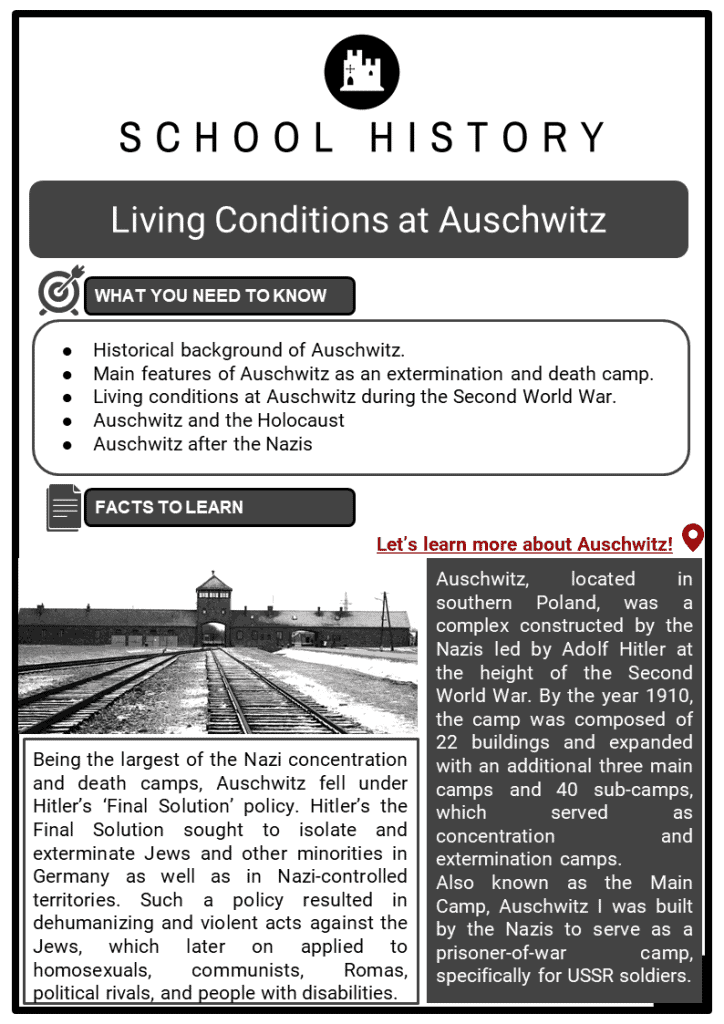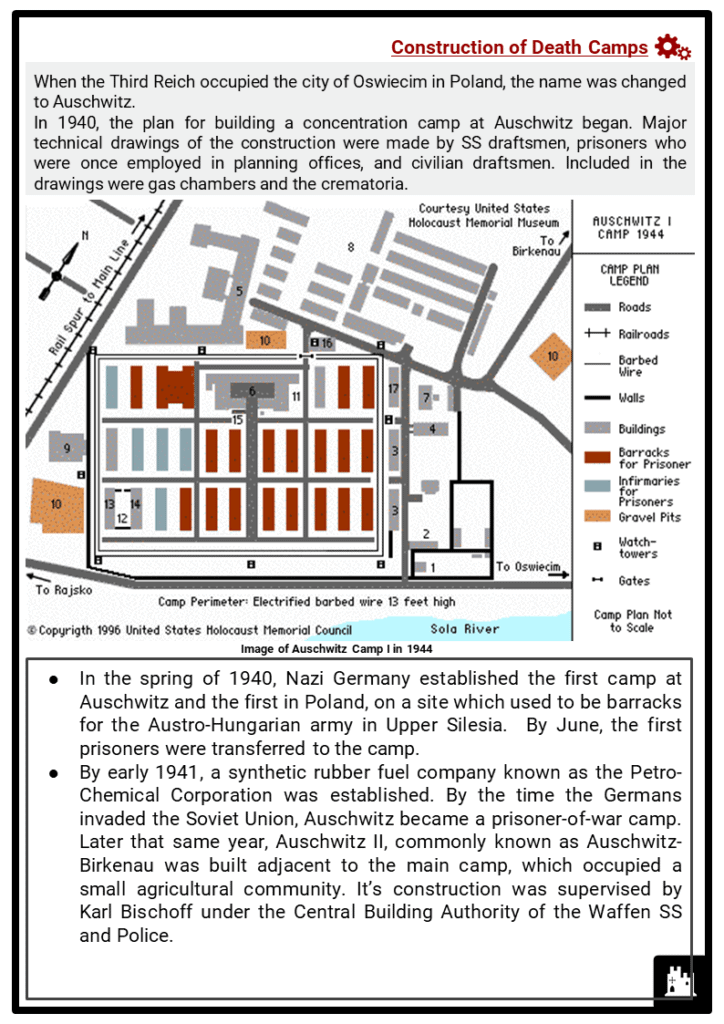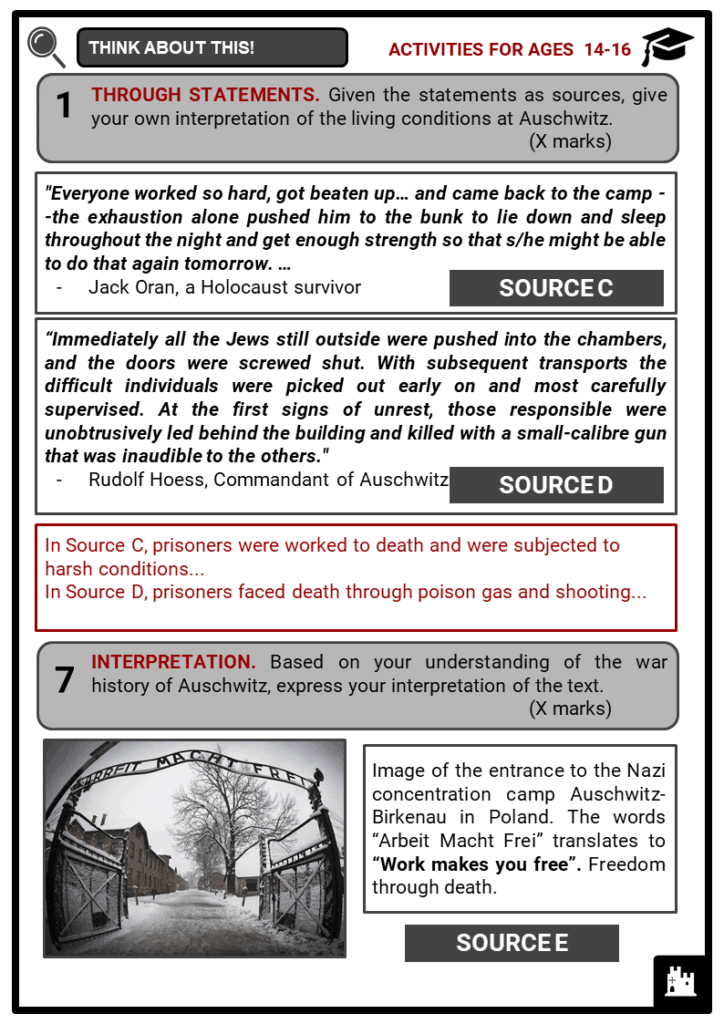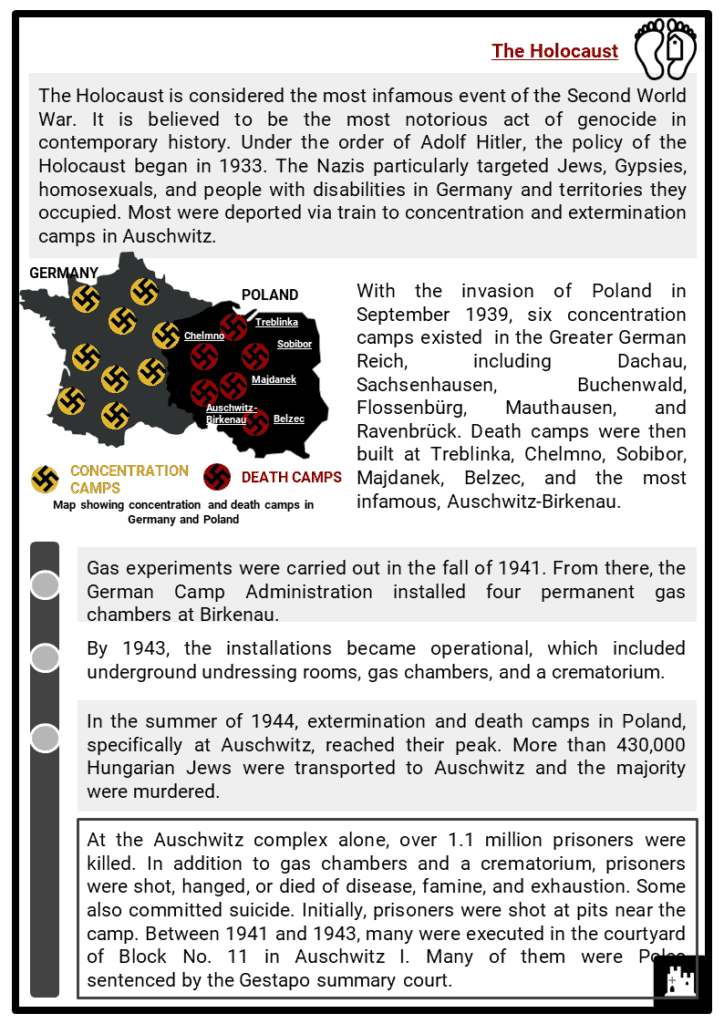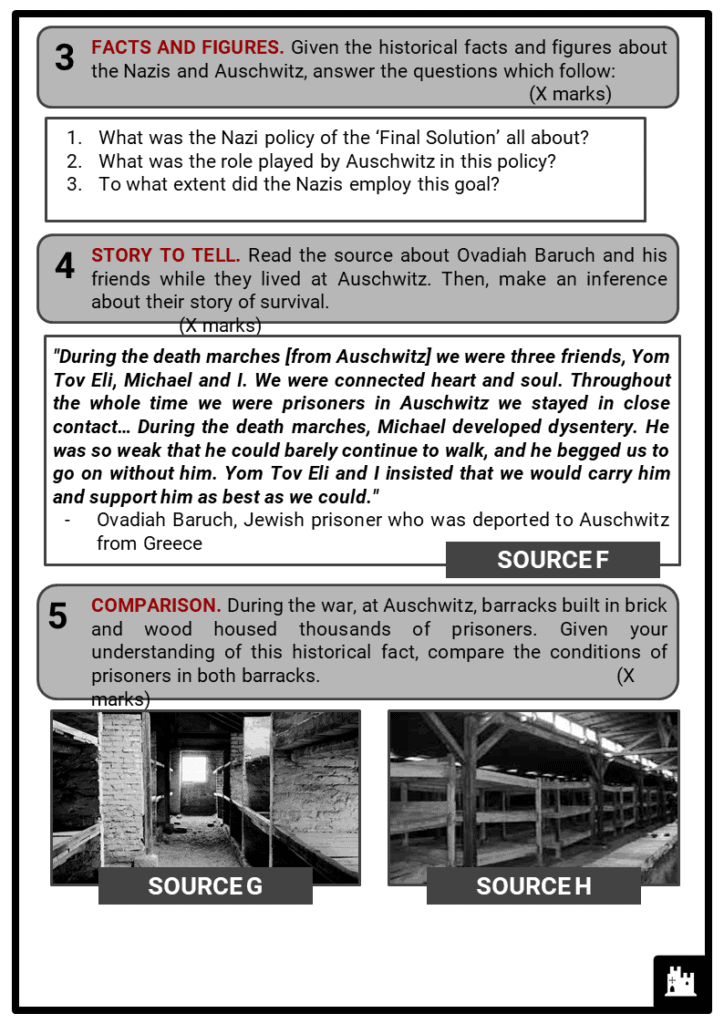Download Living Conditions at Auschwitz Worksheets
Do you want to save dozens of hours in time? Get your evenings and weekends back? Be able to teach Living Conditions at Auschwitz to your students?
Our worksheet bundle includes a fact file and printable worksheets and student activities. Perfect for both the classroom and homeschooling!
Table of Contents
Add a header to begin generating the table of contents
Summary
- Historical background of Auschwitz
- Main features of Auschwitz as an extermination and death camp
- Living conditions at Auschwitz during the Second World War
- Auschwitz and the Holocaust
- Auschwitz after the Nazis
Key Facts And Information
Let’s learn more about Auschwitz!
- Auschwitz, located in southern Poland, was a complex constructed by the Nazis led by Adolf Hitler at the height of the Second World War. By the year 1910, the camp was composed of 22 buildings and expanded with an additional three main camps and 40 sub-camps, which served as concentration and extermination camps.
- Also known as the Main Camp, Auschwitz I was built by the Nazis to serve as a prisoner-of-war camp, specifically for USSR soldiers.
- Being the largest of the Nazi concentration and death camps, Auschwitz fell under Hitler’s ‘Final Solution’ policy. Hitler’s the Final Solution sought to isolate and exterminate Jews and other minorities in Germany as well as in Nazi-controlled territories. Such a policy resulted in dehumanizing and violent acts against the Jews, which later on applied to homosexuals, communists, Romas, political rivals, and people with disabilities.
Construction of Death Camps
- When the Third Reich occupied the city of Oswiecim in Poland, the name was changed to Auschwitz.
- In 1940, the plan for building a concentration camp at Auschwitz began. Major technical drawings of the construction were made by SS draftsmen, prisoners who were once employed in planning offices, and civilian draftsmen. Included in the drawings were gas chambers and the crematoria.
- In the spring of 1940, Nazi Germany established the first camp at Auschwitz and the first in Poland, on a site which used to be barracks for the Austro-Hungarian army in Upper Silesia. By June, the first prisoners were transferred to the camp.
- By early 1941, a synthetic rubber fuel company known as the Petro-Chemical Corporation was established. By the time the Germans invaded the Soviet Union, Auschwitz became a prisoner-of-war camp.
- Later that same year, Auschwitz II, commonly known as Auschwitz-Birkenau was built adjacent to the main camp, which occupied a small agricultural community. It’s construction was supervised by Karl Bischoff under the Central Building Authority of the Waffen SS and Police.
- Initially, the construction was carried out by Soviet prisoners. Soon, many Polish and Jewish prisoners joined them. Compared to the main camp, the camp at Birkenau was made of wooden huts and was originally intended to accommodate 550 prisoners.
- After the construction of Birkenau, it’s function changed to an extermination camp. By the fall of 1941, gas experiments were carried out. Seeing its effectiveness, additional installations were placed.
- Immediately in 1942, existing buildings were converted into gas chambers as well, which began to operate the following year.
- By the first half of 1942, Auschwitz was composed of 28 two-storey blocks. Each block had two large rooms upstairs and smaller rooms downstairs.
- During the Second World War, Auschwitz was divided into several divisions. The main camp, Auschwitz I, housed about 20,000 political prisoners. The main entrance was inscribed with the phrase “Arbeit Macht Frei” or “Work Makes You Free”.
- Birkenau or Brzezinka or Auschwitz II was constructed under the order of Heinrich Himmler, commander of the SS.
- Birkenau was the largest of the Nazi concentration and death camps in Poland, which housed about 90,000 prisoners.
- About 40 smaller camps or sub camps were also utilised in Auschwitz. Most used prisoners as slave labour who were worked to death in industrial plants and farms. Some of the sub camps included Altdorf, Althammer, Babitz, Blechhammer, Bobrek, Budy, Buna, Chelmek, Harmense, Janinagrube, Kobier, Lagischa, Monowitz, Plawy, Tschechowitz, Trzebini, and Sosnowitz.
Life at Auschwitz
- Transported by trains, Jews, homosexuals, people with disabilities, Gypsies, and other ‘undesirables’, as determined by the Nazis, began to arrive at Auschwitz in March 1942. According to estimates, about 4,000 people were registered in both camps and sub camps. However, the numbers were more accurately about 200,000 Jews, 140,000 Poles, 20,000 Gypsies, 10,000 Soviet prisoners of war, and more than 10,000 prisoners of other nationalities.
- Brick and wooden barracks housed prisoners in Birkenau . Built on marshy ground, brick buildings lacked suitable insulation and sanitary facilities. Due to overcrowding, basements and lofts were also filled with prisoners at Auschwitz I.
- Wooden stable barracks in Birkenau were originally designed to house 52 horses. They were partitioned into stalls with three-tier wooden bunks. Aside from leaky roofs, it also lacked appropriate sanitary facilities. Like in the first camps, Monowitz or Auschwitz III had the same features.
- Prisoners were fed rations. Those who had less demanding labour assignments were given lesser-calorie meals per day. However, as the days went by, many experienced malnutrition, deterioration and extreme exhaustion, which caused their deaths.
- Every day, prisoners worked more than 10 hours. They lined up in long roll-call assemblies for food rations. Under the WVHA decree instituted on March 31, 1942, prisoners in concentration camps worked at building the camp, digging drainage ditches, and in factories in sub-camps.
- Auschwitz III or Monowitz was a forced labour camp that supplied men to the IG Farben plant that produced Zyklon B gas.
- In an attempt to hide evidence of mass killings, the Nazis blew up the crematoria and gas chambers before fleeing Auschwitz, however, several parts remained intact.
The Holocaust
- The Holocaust is considered the most infamous event of the Second World War. It is believed to be the most notorious act of genocide in contemporary history. Under the order of Adolf Hitler, the policy of the Holocaust began in 1933. The Nazis particularly targeted Jews, Gypsies, homosexuals, and people with disabilities in Germany and territories they occupied. Most were deported via train to concentration and extermination camps in Auschwitz.
- With the invasion of Poland in September 1939, six concentration camps existed in the Greater German Reich, including Dachau, Sachsenhausen, Buchenwald, Flossenbürg, Mauthausen, and Ravenbrück. Death camps were then built at Treblinka, Chelmno, Sobibor, Majdanek, Belzec, and the most infamous, Auschwitz-Birkenau.
- Gas experiments were carried out in the fall of 1941. From there, the German Camp Administration installed four permanent gas chambers at Birkenau.
- By 1943, the installations became operational, which included underground undressing rooms, gas chambers, and a crematorium.
In the summer of 1944, extermination and death camps in Poland, specifically at Auschwitz, reached their peak. More than 430,000 Hungarian Jews were transported to Auschwitz and the majority were murdered. - At the Auschwitz complex alone, over 1.1 million prisoners were killed. In addition to gas chambers and a crematorium, prisoners were shot, hanged, or died of disease, famine, and exhaustion. Some also committed suicide. Initially, prisoners were shot at pits near the camp. Between 1941 and 1943, many were executed in the courtyard of Block No. 11 in Auschwitz I. Many of them were Poles sentenced by the Gestapo summary court.
- From September 1941, about 2,000 Soviet prisoners of war were executed at Auschwitz through poison gas. In 1944, Poles who were sentenced by the summary court were executed through gas chambers. Some were hanged in public, mostly during roll call.
- Historians believed that about 80% of the prisoners brought to Auschwitz were gassed just few hours after their arrival. Some were selected to work, and those individuals likely only survived 3 months.
- In July 1934, after the elimination of the SA and the purge of Ernst Röhm, SS leader Himmler centralised the administration of the concentration camps. He appointed SS Lieutenant General Theodor Eicke to manage the camps. From then, the SS became the only authorised body to run the concentration camps.
- On January 1, 1934, the Law for the Prevention of Genetically Diseased Offspring came into effect. It decreed that any person with a hereditary disease should undergo medical experiments and forced sterilisation.
- In addition to about six million Jews, scholars estimate that there were more than five million non-Jews who were murdered during Nazi rule. These included Gypsies, homosexuals, Jehovah’s Witness, black people, opposing clergymen, people with disabilities, prisoners of war, Slavs, and political opponents.
- To justify the Holocaust, the Nazis believed that the Aryan race was superior to all other groups and it should remain pure.
- Between 1939 and 1941, about 50,000 people with mental disabilities were gassed with carbon monoxide under Hitler’s T4 programme.
- German children with blonde hair and blue eyes were raised by the Nazis as a pure Aryan race, while those who had dark hair were sent to concentration camps or subjected to experiments.
Auschwitz after the Nazis
- On January 27, 1945, the Soviet Red Army liberated prisoners at Auschwitz. They took over the camps and provided hospitals assisted by the Polish Red Cross.
- The troops who first arrived at Auschwitz witnessed suffering people, human excrement and ashes all over the place, specially in crematoria.

